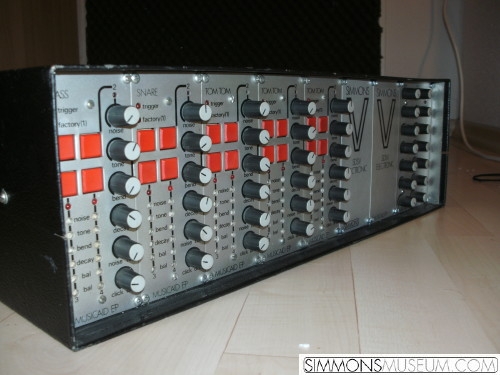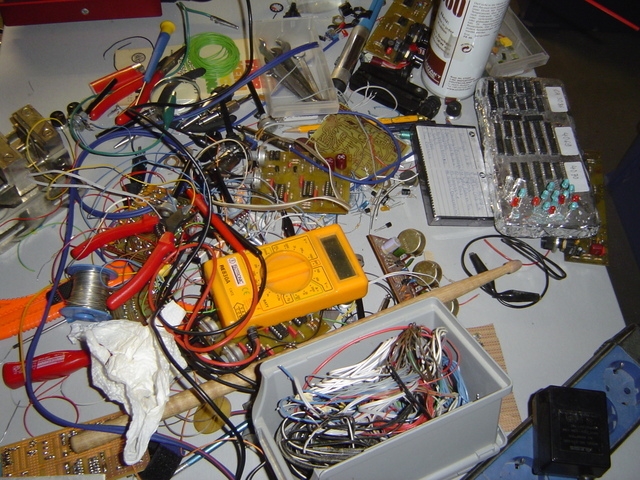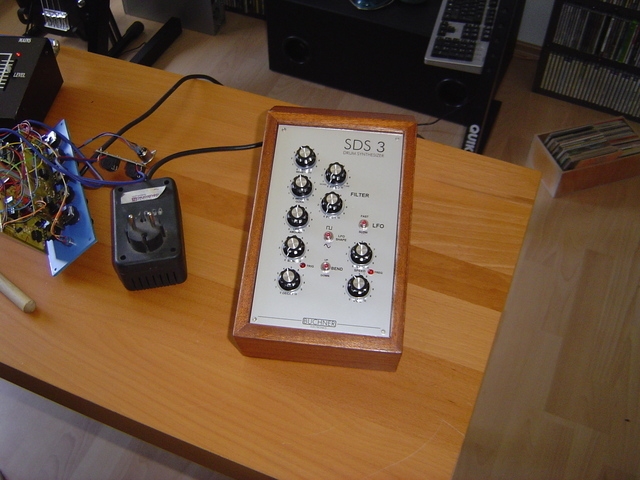Last week a guitar player told me about the unique opportunity to buy a Fender Stratocaster from the Pre-CBS area for a “tip amount” of only €3000-5000. That reminded me of the fact that the Simmons history was devided into the Musicaid- and the Simmons Electronics epoch. OK, probably this comparison is misleading, but still there are parallel aspects. I got my first (complete and mint) SDSV produced as Musicaid. There are some obvious differences (I have not opened it yet so there will be likely some more inside, specially concerning the modules):

- The outer cover is made of imitation leather instead of bended sheet metal
- The inner frame is not yet zinc-coated. That might lead to major rust occurence depending on the storage environment
- The frame is slightly bigger so a sheet metal cover from a later device would not fit over a Musicaid SDSV frame
- The knobs used for the modules and mixer section are a bit bigger and different to later SDSV devices
- no rubber feat on the bottom for desktop use
- the panels show “Musicaid EP” instead of “Simmons”
- The pushbuttons are red instead of black

From the Complete Simmons Drum Book by Bob Henrit: “… At roughly the same time that Simmons products were becoming a force to be reckoned with, disaster struck. In November 1981 the Musicaid company collapsed. They were desperate for some development money so that SDS.5 could be produced in significant quantity, but were unable to raise the necessary funds from an associate investment company who already had a financial interest. The company was burdened with unwasted general music stock and eventually went into voluntary liquidation. Musicaid could have been saved for as little as £20.000 – a minute sum to secure the future of such a world-beating product, however at that time it was impossible to raise. They still had faith and hope, but precious little charity!
Dave Simmons understandably looks upon this time as being the most traumatic of his life. His workforce were on the dole and had a very lean Christmas at the end of 1981, and he not only had to deal with irate creditors, he had to try to sort out the future too. He was certain that SDS.5 was a world-beating product, but in the light of Musicaid’s demise, he not surprisingly found it extremely difficult to persuade people to invest in it. His only hope was his personal bank. Ultimately it was his wife Kirsty who was able to persuade the bankers to part with the £10.000 necessary to start a completely new comapny and go ahead with production. A company called ‘Clipfinch’ was bought ‘of the shelf’ for £100, and once things began to tick over nicely its name was duly changed to Simmons Electronics. …”
Particularly this device was a guest of my museum in 2010 when the former owner asked me for an expertise. It had been originally delivered with the wooden pads I wrote about last year. At that time I changed a set of pure white and mint SDSV pads for these wooden collectibles. He wanted to keep the brain (or sell it for more money I was willing to give…) and recently sold it for no less than €1500. The buyer was desperately looking for an SDSV for years. He tried it with Roland mesh head pads but soon found out that the brain demands sharp trigger pulses from rock hard SDSV pads in order to avoid destorted sounds. So we made the deal that he gets one of my newer Simmons SDSV, 5 module standard version, with a higher serial number (#502), complete with pads, sands and cables and I get the Musicaid SDSV in mint condition. A good deal for both parties as far as I can estimate. What do we learn? Finally Simmons gear end up in my house…




